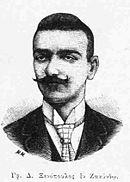Modern Greek theatre
| Part of a series on the |
| Culture of Greece |
|---|
 |
| People |
| Languages |
|
Mythology |
| Cuisine |
| Festivals |
|
Art |
Modern Greek theatre refers to the theatrical production and theatrical plays written in the
Venetian Crete

The renaissance which led to the modern Greek theatre took place in the
Heptanesean theatre
After the occupation of
Notable playwrights include Petros Katsaitis, Savoyas Rousmelis and Dimitrios Gouzelis. One of the most notable works was Vasilikos (1830) by Antonios Matesis.
Greek Enlightenment and Independence


During the pre-revolution years, notable theatrical works include the Achilleus or Death of Patroclus (1805) by Athanasios Christopoulos, Timoleon (1818) by Ioannis Zambelios, while Korakistika (1812) by Iakovakis Rizos Neroulos was a lampoon against the Greek intellectual Adamantios Korais and his linguistic views (Katharevousa).
After independence, the theatrical scene of the new
The
With the appearance of the New Athenian School (or Palamian), in the late 19th century, and the central figure of Kostis Palamas, the use of Demotic Greek became more acceptable. However, in 1903, a translation by the Royal Theatre of Aeschylus' Oresteia into the spoken Greek language (not Katharevousa) provoked protests by conservative students.
Playwrights and dramatists of the new era included
The Royal Theatre was re-founded in 1932 as National Theatre. The first plays staged were the Aeschylus' Agamemnon and Gregorios Xenopoulos' comedy O theios Oneiros. The first actor team included Katina Paxinou, Aimilios Veakis, Eleni Papadaki and Alexis Minotis. First theatrical director was placed Fotos Politis and from 1934 Dimitris Rontiris.
After WWII
After the war, new playwrights appeared, like Dimitris Psathas, Nikos Tsiforos. Their work in many cases was transferred in the cinema. For example, most of the plays of Sakellarios/Giannakopoulos (around 140), were transferred also in the cinema.
Significant theatrical actors appeared also in the movies of the
Iakovos Kambanellis was probably the most significant post-war Greek playwright, while Karolos Koun was also a notable director, widely known for his lively staging of ancient Greek plays.
See also
- Athens Festival
References
- Γραμματάς Θ. 1987, «Η παρουσία της commedia dell’arte στο επτανησιακό θέατρο του ΙΗ’ αιώνα» στο Νεοελληνικό θέατρο Ιστορία-Δραματουργία, Κουλτούρα, Αθήνα.
- R. Beaton, An Introduction to Modern Greek Literature, Oxford University Press, 1999.
- D. Holton, Μελέτες για τον Ερωτόκριτο και άλλα νεοελληνικά κείμενα - Studies on Erotokritos and other Modern Greek texts, ed. Kastaniotis, Athens 2000. (in Greek)
- M. Vitti, Ιστορία της Νεοελληνικής Λογοτεχνίας [History of Modern Greek Literature], ed. Οδυσσέας, Athens, 2003.
